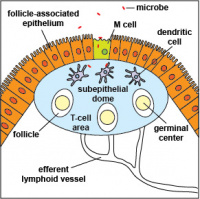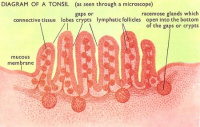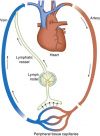Anatomy/Lymphatic System
This page is incomplete. |
The lymphatic system is a focus topic of the event Anatomy and Physiology. It was tested for the first time in the 2019 season.
Overview
The lymphatic system is a network of vessels and nodes that transport lymph throughout the body. It is closely connected with immunity, as lymph helps the body fight off infection. Lymph is stored in clumps of tissue called lymph nodes. The lymphatic system consists of primary lymph organs where lymphocytes mature, as well as secondary or peripheral lymph organs that maintain mature naive lymphocytes and facilitate adaptive immunity.
Functions
The lymphatic system functions to:
- return tissue fluid to the bloodstream
- transport fats from the digestive system to the bloodstream
- return other large molecules such as proteins to blood
- provide surveillance and defense against disease
- hemopoiesis (production of lymphocytes)
Lymph
Lymph is a clear, watery fluid that is most similar to the interstitial fluid of the body and contains fewer proteins than blood plasma. The lymphatic system filters 2500 to 2800 milliliters (mL) of lymph a day, and approximately half comes from the liver and small intestine alone.
Lymphatic Tissue
The three types of lymphatic tissue are:
- diffuse lymphatic tissue
- otherwise known as MALT, GALT, SALT, etc.
- found in connective tissue of most organs
- no capsule found
- lymphatic nodules
- no capsule found
- oval-shaped masses found singly or in clusters
- lymphatic organs
- capsule present
- filter tissue fluid
Lymphatic Structures
Lymph Nodes
There are up to 600 lymph nodes spread throughout the body, most occurring in groups or clusters. The most common regions are the submental/submaxillary region, the cervical region, the axillary region, and the inguinal region.
Submental/submaxillary lymph nodes are found in the floor of the mouth and drain lymph from the nose, lips, and teeth. Cervical lymph nodes are in the neck, draining the neck and head. Axillary lymph nodes are located in the armpit and upper chest, draining the arm and upper thorax. The upper thorax includes drainage from the skin over the breast and deeper portions of the breast. Inguinal lymph nodes are in the groin and drain the legs and genitals.
Lymphatic Ducts
Lymphatic ducts are similar to the major vessels of the cardiovascular systems but are more like veins than arteries. The two major lymphatic ducts are the right lymphatic duct and the thoracic duct. The right lymphatic duct drains the upper right quadrant of the body into the right subclavian vein and jugular vein. The thoracic duct drains the remaining 75 percent of the body: everything below the diaphragm, the left arm, and the left side of the head, neck, and thorax.
Accessory Lymphatic Organs
Tonsils
The tonsils are clusters of lymph nodes embedded at the base of the pharynx or throat. Tonsils contain deep pits called crypts which hold food debris, bacteria, and white blood cells. The three main sets of tonsils are: the pharyngeal tonsils, or adenoids; the palatine tonsils; and the lingual tonsils.
The adenoids can be found on the wall of the nasopharynx. The palatine tonsils are located at the edge of the oral cavity, or on the palate of the mouth. The palatine tonsils are the largest and most susceptible to infection (tonsilitis). Lingual tonsils are present on each side of the root of the tongue.
Spleen
The spleen is the largest of the lymphatic organs, and it is located below the diaphragm on the left side of the abdomen. The spleen detects antigens and provides defense against pathogens, produces monocytes and lymphocytes as well as fetal erythrocytes, destroys red blood cells and platelets, and filters and stores blood. The spleen's sinuses can store approximately 350 mL of blood and pump blood into the cardiovascular system in case of damage. It also transfers excess plasma from the blood to the lymphatic system.
Thymus
The thymus is located in the mediastinum (area between the lungs) and neck region. It is largest in infants and children and can reach a mass of 30 to 50 grams during puberty, later degenerating with age. The thymus aids in the production of lymphocytes, and it is the site of maturation for T-cells.
Peyer's Patches
Peyer's Patches are small masses of lymphatic tissue found in the ileum of the small intestine. They analyze and respond to pathogens in the intestine.
Appendix
The appendix has a minor role in immunity because it stores good bacteria. Blockage can lead to appendicitis, which can be fatal if the appendix ruptures.
Relation to Cardiovascular System
The lymphatic system is directly connected to the circulatory system, but there are a few notable differences. Unlike the cardiovascular system, the lymphatic system is a one-way system. The lymph vessels do not form a complete circuit between the lymph organs, and lymph is not "pumped" like blood. The lymphatic system also lacks arteries. However, lymphatic and blood vessels both have the same three tunics, and valves to prevent backflow. Lymph is moved by contractions of skeletal muscle and other body movements, and leakage from lymphatic vessels enters cardiac vessels to increase blood volume. Likewise, lymph vessels act as a reservoir for cells and fluid that escape the cardiovascular system.
Disorders
Swollen Glands
Swollen glands, also known as swollen lymph nodes or lymphadenitis, occur as a result of infection. Symptoms may include tenderness and pain and swelling the size of a pea or kidney bean. Other symptoms, such as respiratory symptoms, fever, or night sweats, depending on the cause of inflammation. Generalized swelling throughout the body may indicate an autoimmune disorder such as systemic lupus erythematosus or HIV.
LAM
Lymphangioleiomyomatosis (LAM) is a rare disease that causes muscle-like cells to grow in certain organs or tissues, especially the lungs, lymph nodes, and kidneys. The two main forms are sporadic LAM or TSC-LAM, which is LAM that occurs along with tuberous sclerosis complex (a rare disease causing tumors to develop throughout the body).
Edema
Edema is an excessive accumulation of interstitial fluid. It can result from any disruption of lymphatic flow, such as injury, inflammation, surgery, or parasitic infections.
Hodgkin's Disease
Hodgkin's disease is a malignancy of the lymph nodes. The nodes become enlarged and painful, especially the cervical nodes.
Non-Hodgkin's Lymphoma
Non-Hodgkin's Lymphoma is a more common form of Hodgkin's Disease, with more widespread malignancy and a higher death rate.
Ruptured Spleen
A ruptured spleen occurs as a result of trauma to the left thoracic or abdominal wall. This rupture may cause fatal hemorrhaging, and the spleen must be removed. However, removing the spleen does not hinder lymphatic function.
Elephantitis
Lymphatic filariasis, or elephantitis/elephantiasis, is a vectorborne disease in which the patient is bitten by a mosquito infected with a filarial worm, and the resulting edema leads to fibrosis and severe thickening of the skin.
There are other forms of elephantiasis that can be caused by chronic lymphatic obstructions, such as nonfilarial elephantiasis (podoconiosis), elephantiasis nostras, and elephantiasis in cancer patients.
See Also
Resources
Lymphatic System on Khan Academy
Lymphatic Training Handout/PPT
Primary and Secondary Lymphatic Tissue
Diffuse Lymphatic Tissue




